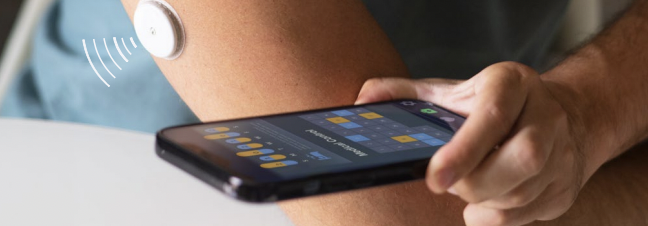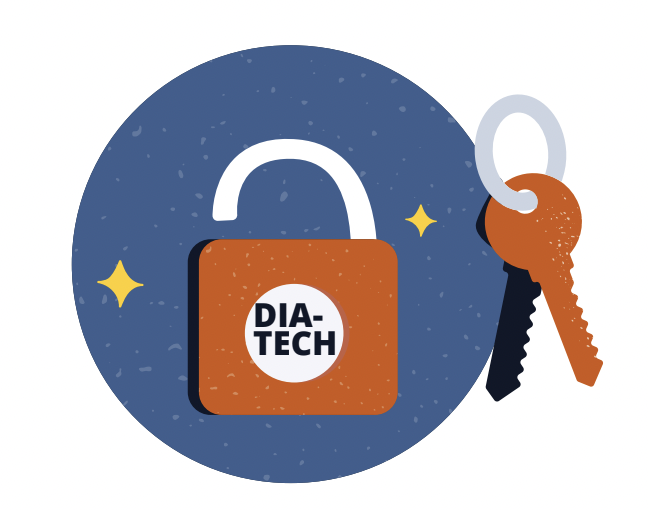How to Talk About Diabetes-Related Technology
A resource for healthcare heroes
There have been many innovations in the technology that people with diabetes use to monitor their glucose levels and deliver insulin in recent years.

Continuous glucose monitors (CGM), insulin pumps, and automated insulin delivery (AID) systems have all contributed to helping people better manage their diabetes.
However, conversations around diabetes-related technology and devices can sometimes feel inaccessible and stigmatizing. This guide is designed to help you navigate these conversations with people with diabetes in your practice in a more respectful and inclusive way.
General language guidance
People with diabetes, their families, and people at risk of diabetes deserve communications that are clear and accurate, respectful, inclusive, and free from judgment and bias.
No matter what the topic, there are some basic guidelines that everyone can implement. Choose to use language that:
- Is neutral, nonjudgmental, and based on facts, actions, or physiology/biology.1,2
- Is strengths-based, respectful, inclusive, and imparts hope.1,2
- Is person-centered.1,2
- Fosters collaboration between people with diabetes and healthcare teams.1,2
When a conversation centers around diabetes-related technology, the important things to take away from these general guidelines are that:
- Technology – and the data that a person with diabetes interacts with – can be fraught with value judgment terminology (“Your time in range has been really bad lately, have you been following my instructions?”). By focusing on facts and numbers you can help remove feelings of failure or judgment (“Your time in range has been hovering around 60%. Let’s look at your CGM data and find ways to get that number closer to our goal of 70%.)
- People may feel discouraged if technology “doesn’t work” for them. Be supportive and ask questions about what is working and what isn’t, especially when someone is first starting a new device. Focusing on strengths-based feedback (“It looks like your glucose levels are always in range when you use your AID system at dinner time. That’s great; are you doing anything different for that meal?”)
For more information about general language guidance that can help reduce diabetes stigma, including specific words and phrases to use (or avoid), visit the dStigmatize Language Guide.
Have a stigma-free conversation about diabetes technology
1. Ask lots of questions, be an active listener, and share in the decision-making.
Anytime you have a conversation about diabetes devices with someone who has diabetes and their family, it’s important to meet them where they are. This means taking into account a person’s knowledge about diabetes devices, their day-to-day lives, and their personal health goals. It’s your job as a health professional to ask questions that can help guide the conversation, while allowing each person to have a say in the decision-making process.

2. Avoid “gatekeeping” certain devices or diabetes-related technology.

A common mistake that health professionals make is not discussing certain diabetes devices with someone because of assumptions about their ability or desire to use a device.
All too often health professionals assume that someone can’t afford a device, isn’t tech-savvy enough, won’t use the device correctly, or hasn’t “earned” a device, even though the right devices can drastically reduce the burden of diabetes management and are life-saving for some people.
Instead of gatekeeping, share and discuss all of a person’s options when it comes to diabetes-related technology, including the benefits and drawbacks of each, and allow space for people to ask questions.
3. Acknowledge the psychosocial impact of using diabetes-related technology.
Diabetes-related technology can have major psychosocial impacts on people with diabetes.
Using a wearable medical device like a CGM or insulin pump can sometimes create body image issues. In addition to that, the use of these devices, or other devices such as a blood glucose meter might draw unwanted attention to someone and make their diabetes more “visible,” thereby increasing the risk of experiencing diabetes stigma.

Device alarms and alerts, while important safety measures, can be an annoying burden to many and a constant reminder of the attention that diabetes demands. And, especially with newer technology such as CGMs and insulin pumps, there can be an overwhelming amount of data that a person is forced to interact with. This can compound existing levels of diabetes distress, burnout, or anxiety.
It’s important to be mindful of concerns that people might have when it comes to starting or using diabetes devices and that you can point people in the direction of mental health resources if needed.
Choose the right words and phrases
Example 1
Instead of “adhere” or “comply”
adherence / compliance; e.g. adhere, (non-) adherent, comply, (non-) compliant
Choose
words that describe collaboration or doing specific behaviors, e.g. taking medication, checking glucose levels
Use
- “Jan checks her glucose levels regularly with her CGM.”
- “What do you like about your insulin pump? Are you running into any challenges?”
Rather than
- “My patient, Jan, complies with my recommendation to use a CGM.”
- “The patient is difficult and non-compliant. I do not recommend they continue with using an insulin pump.”
Rationale
Using terms that emphasize collaboration can be empowering and highlights that people with diabetes are not passive in the management of their condition, but should be a part of decision-making. Words like ‘adherence’ and ‘compliance’ suggest that health professionals are always correct and that people with diabetes are disobeying them if they are not able to follow orders exactly. In reality, diabetes management is more complicated than simply ‘following orders’ – especially when it comes to complex devices – and terms like ‘adherent’ and ‘compliant’ ignore the many challenges people with diabetes face every day.
It is accurate, descriptive, and neutral to describe the actual choices or behaviors of a person with diabetes and its effects on health outcomes.
Example 2
Instead of “control”
control (referring to diabetes, HbA1c or glucose levels);
e.g poor control, good control, normal control, well controlled, poorly controlled, uncontrolled, glycemic control
Choose
manage glucose levels, within/outside target range, high/low glucose levels, target glucose levels, [“ …experienced ____ and the result was ____”]
Use
- “Tim manages his diabetes using an AID system and is in range 80% of the time.”
- “I can see in your CGM data that you’ve had a few glucose levels outside your target range. Can we take a closer look at why these might be occurring?”
Rather than
- “Tim controls his diabetes using an insulin pump, but he still has really poor time in range.”
- “My patient has poorly controlled diabetes and has not shown they deserve more advanced diabetes devices such as an automated insulin delivery system.”
Rationale
A person’s diabetes is influenced by many factors outside of their ‘control’ including socioeconomic factors, hormones, access to medications and technology, their environment, stress, etc.2
‘Management’ is preferred over ‘control’ because it acknowledges the effort people put in to maintain their health and it acknowledges the improvements people can make over time. The term ‘control’ can lead to feelings of guilt, shame, and frustration and incorrectly implies that if people try hard enough they can ‘control their diabetes.2’
Example 3
Instead of “fail”
fail, failing to, failed, failure; good/bad/poor (referring to glucose levels)
Choose
did not, has not, does not…
use the numbers, refer to choices
Use
- “Sara started using an insulin pump but hasn’t been able to increase her time in range. We should explore what challenges she might be facing.”
- “Your time in range is steady at around 50%. I know your goal is to be closer to 70%. Perhaps we could explore some other device or medication options to help you reach your goals.”
Rather than
- “Sara failed to control her diabetes even with an insulin pump.”
- “My patient consistently has poor time in range.”
Rationale
When discussing the choices people make and the health outcomes that result, it is more accurate and considerate to be descriptive and neutral without assigning a value judgment to the choice or result, such as ‘failed,’ ‘good,’ ‘bad,’ or ‘poor.’ All of these terms can lead to people with diabetes feeling guilty, blamed, or ashamed of the choices they make.2
Example 4
Instead of “test”
test/testing (when referring to blood glucose monitoring or fingersticks)
Choose
check/checking; monitor/monitoring (e.g. glucose); read/reading (e.g., on a CGM)
Use
Evita checks her glucose levels with her continuous glucose monitor.
Rather than
Evita tested her blood sugars.
Rationale
‘Tests’ are associated with results, scores, or grades. ‘Testing’ your glucose levels can imply that you’re getting a score or grade, which can cause feelings of ‘failure’ if people see a value that is off target. Using words like ‘check’ or ‘monitor’ are more motivating words that provide people with diabetes with information they can act on without the negative connotation.2
This resource was created for dStigmatize, a diaTribe Foundation program, with support from Lilly Diabetes, AstraZeneca, and the Boehringer Ingelheim-Lilly Alliance.



Citations
- Dickinson, J. K., Guzman, S. J., Maryniuk, M. D., O’Brian, C. A., Kadohiro, J. K., Jackson, R. A., D’Hondt, N., Montgomery, B., Close, K. L., & Funnell, M. M. (2017). The Use of Language in Diabetes Care and Education. Diabetes care, 40(12), 1790–1799.
- Speight, J., Skinner, T. C., Dunning, T., Black, T., Kilov, G., Lee, C., Scibilia, R., & Johnson, G. (2021). Our language matters: Improving communication with and about people with diabetes. A position statement by Diabetes Australia. Diabetes research and clinical practice, 173, 108655.